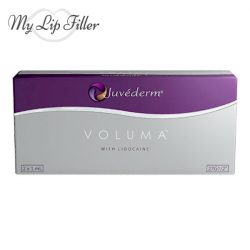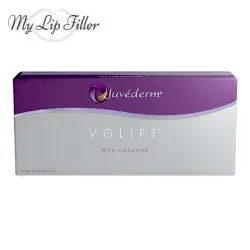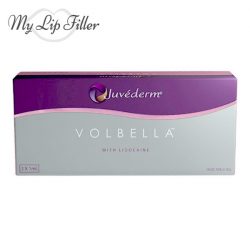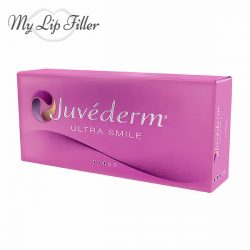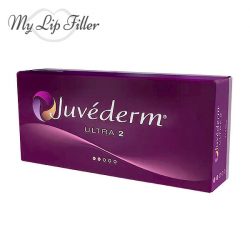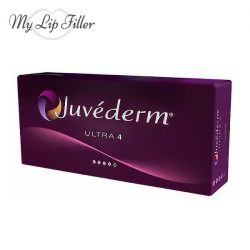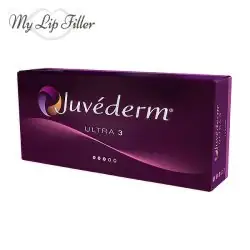Hyaluronic acid fillers absolutely dominate their nice of the market. For a variety of reasons, HA makes, arguably, the most versatile base for skin filling gel. Thus, there is an oversaturation of available offers and products used for anything – from correcting superficial wrinkles and restoring volume under eyes to chin fillers for facial contouring. Yet, the Juvederm line is a standout. A name synonymous with quality and reliability, a line for fillers good for almost all types of filling corrections to the face. So, on the surface, making an Aesthefill vs Juvederm for cheeks (or any other part of the face) comparison, could a appear a bit of left field. However, there is a decent overlap in regard to the usage of the two.
Dermal filler ingredients
While putting the Juvederm brand against the Aesthefill, this should be considered a broader comparison, which also includes other PLLA solutions like A-Jax D’Azur or Sculptra. The core difference between Aesthefill and Juvederm is that at the heart of Juvederm is Hyaluronic acid – a natural compound, which can be found in animals and plant, as well as the human body. It is widely used in the beauty industry, as it makes for a great foundation for filling gel which can be used to correct wrinkles and other skin depressions. Not only is Ha safe, as it’s natural tot eh body and is fully biocompatible, but the gel manufactured based on it is safely biodegradeable.
On the other hand, products like Aesthefill, Sculptra and A-Jax J’Dazure are made from various forms of Poly-L-Lactic acid (PLLA, PD-LLA and PLA). This is an artificial but safe polymer which is proven to naturally dissolve by the body’s enzymes, which leaves no harmful residue. Normally PLLA products come in a powdered form and are prepared in a mixture of sterile saline. The core of what is Aesthefill or A-Jax D’Azur is a dissolvable filler, unlike the Juvederm solutions which come in a ready to work with Hyaluronic acid gel.
Treatment areas addressed
There is also a stark difference, as with most PLLA based face fillers Aesthefill and A-Jax D’Azur are a single line product. On the opposite end Juvederm includes multiple filler solutions for chin, jawline, lips, etc.:
Ultra – the “standard” order product line includes:
- Ultra Smile
- Ultra 2
- Ultra 3
- Ultra 4
Vycross – the premium line has:
- Volite
- Volbella
- Volift
- Volume
- Volux
Being a premium line of Hyaluronic fillers, Juvederm includes products with different viscoelasticity, molecular weight, HA concentration and so on, which will work best in different scenarios. From superficial wrinkles to deep facial contouring, there is a Juve filler to work with.
Aesthefill and A-Jax D’Azur are a bit different in that regard. Since they are fillers based on the regaining or adding volume based on collagen production, they will not work for lips. Additionally, the injection method and depth they are used at are extremely important. Aesthefill for cheeks is added to the subcutaneous layer via the liner method, while mid face and chin will be treated using the panning technique at the submental submandibula level.
What is the difference between Aesthefill and Juvederm?
When treated with A-Jax D’Azur or Aesthefill nasolabial folds are corrected in a way which is markedly different than what a traditional filler like Juvederm does. Juve is a high quality, but fairly standard HA gel substance. Depending on the product and the part of the face, which are treated, it’s clear that the differences between the two types of products go beyond what they are made of.
Juvederm’s gel naturally “blends” with the skin tissues. Ideally, the HA gel perfectly fits into the skin depression or volumizes the chin, after which it will dissolve safely for an extended period of time. After the initial application volume is gradually lost. Hyaluronic acid fillers provide immediate volume increase / skin smoothing, while the long-term effect of Juve and Juvederm alternative products is in the of improved hydration, for an average of a year or so.
Aesthfill and A-Jax D’Azur, on the other hand, provided somewhat limited initial filling effect. It’s worth noting not all collagen fillers are instantly volumizing. However, the standard PLLA and PD-LLA solution, when prepared correctly, does also give volume. The miniature polymer spheres are suspended in the prepared gel. This is quicker to dissolve than a Vycross filler and not as long as Juvederm lasts, however, new skin cell structures will form promoting collagen synthesis and natural build-up of the supportive dermal tissues. It can take over an year for the optimal results to be achieved and PLLA fillers are good for people interested in long term and natural solutions.
Radiesse versus Juvederm: Comparison Chart
| Juvederm | Aesthefill | |
| Multiple product entries | Yes | No |
| Wrinkle removal | Yes | Yes |
| Facial contoruing | Yes | Yes |
| Lip enahncement | Yes | No |
| Ready to use | Yes | No |
| Gel form | Yes | No |
| Duration | 6-14 months | 12-24 months |
| Semi-permanent | No | Yes |
Making a direct comparison between what’s Juvederm or any other regular HA filler and PLLA products like Aesthefill and A-Jax D’azur is somewhat difficult, due to the fundamentally different philosophies of the two types or product, as well as the areas where they are used, the type of material they are made of and so on.
Comparing results of Aesthefill vs Juvederm
When putting the bro brands side to side, the end results are very much determined by the technology behind either filler, as well as the main ingredients. One of the key points for Juvederm’s popularity is that it is very safe, but yet effective. In many ways the Juvederm manufacturer has achieved wonders, especially regarding the Vycross line, taking the Juve fillers to the next level, even though they are still made of Hyaluronic acid, at their core. No matter if augmenting the chin or used on the lips or temples, Juvederm offer an unmatched natural look, even when compared to other premium brands. And has far as HA gel goes, regardless if looking the soft fillers for superficial wrinkles or the dense solutions for contour, facial sculpting or cheek fillers, this is, hands down, the most durable brand of Hyaluronic fillers sold. It’s a type of brand that offers pure reliability for dermatologists / licensed practitioners and their patients.
Aesthefill (or A-Jax D’Azur) on the other hand, are the best option for people interested in a long-term fix. Often referred to as “semi-permanent” fillers, the Poly-L-Lactic polymer will outlast its initial gel suspension for quite a while. But over time, as the initial gel dissolves, it is gradually replaced by new and healthy dermal cells. The PLLA spheres act as a matrix for new skin tissues and induce the synthesis of collagen as new skin cells are created. With a duration of up to two years, it might not be permanent, but it still givers Juvederm Voluma a run for its money.
-
Product on sale
 Juvederm Voluma (2 x 1ml)Original price was: $320.00.$304.00Current price is: $304.00.
Juvederm Voluma (2 x 1ml)Original price was: $320.00.$304.00Current price is: $304.00. -
Product on sale
 Juvederm Volift (2 x 1ml)Original price was: $320.00.$304.00Current price is: $304.00.
Juvederm Volift (2 x 1ml)Original price was: $320.00.$304.00Current price is: $304.00. -
Product on sale
 Juvederm Volbella (2 x 1ml)Original price was: $320.00.$304.00Current price is: $304.00.
Juvederm Volbella (2 x 1ml)Original price was: $320.00.$304.00Current price is: $304.00. -
Product on sale
 Juvederm Ultra Smile (2 x 0.55ml)Original price was: $169.00.$160.55Current price is: $160.55.
Juvederm Ultra Smile (2 x 0.55ml)Original price was: $169.00.$160.55Current price is: $160.55. -
 Juvederm Ultra 2 (2 x 0.55ml)$163.00
Juvederm Ultra 2 (2 x 0.55ml)$163.00 -
Product on sale
 Juvederm Ultra 4 (2 x 1ml)Original price was: $244.00.$231.80Current price is: $231.80.
Juvederm Ultra 4 (2 x 1ml)Original price was: $244.00.$231.80Current price is: $231.80. -
Product on sale
 Juvederm Ultra 3 (2 x 1ml)Original price was: $244.00.$231.80Current price is: $231.80.
Juvederm Ultra 3 (2 x 1ml)Original price was: $244.00.$231.80Current price is: $231.80.
Juvederm VS Aersthefill: For lips
One of the things that confuse people is the fact that PLLA filler are not used for lips. While Juvederm can offer excellent solutions like Ultra 3, Ultra Smile or Volbella and Volift (depending on the expected lip firmness), Aesthefill and A-Jax D’azur are not good for that particular area. Inducing collagen buildup in the lips will not only be ineffective, but can potentially cause issues, meaning PLLA fillers are not suitable. Juve lip fillers, on the other hand, are perfectly safe, not only because of the technology and quality, but also due to what is in Juvederm – Hyaluronic acid.
Treatment time
Juvederm products are ready to use out of the box. Everything necessary for the dermatologist or practitioner is included in there. The very short duration of the procedure is one of the many factors making fillers the preferred contemporary option to traditional plastic surgery. Normally, Hyaluronic filler application takes between 20 and 30 minutes, on average. This is similar with PLLA and PD-LLA based collagen stimulating fillers like Aesthefill or A-Jax D’Azur. However, a certain amount of preparation time is also necessary, until the solution is good for usage, normally a total of 60 minutes until appropriate to do so. Also, when compared to Juvederm injection technique is a more prominent determining factor for the duration of the procedure when talking about PLLA solutions, although it factors in with HA fillers, as well.
Recovery after procedures
One of the many advantages of fillers, be they PLLA based or Hyaluronic acid solutions, is how non-invasive they are. Patients can expect to continue with their normal routine immediately after the procedure. In the vast majority of instances, no downtime is required and any adverse reaction are minimal and inconveniences like swelling will subside in just a couple of days.
Comparing the side effects
It cannot be stressed enough how vital is for the dermatologist or other licensed practitioner handling the procedure to do a preliminary interview with the patient. A good day to anticipate the Aesthefill or Juvederm side effects is to make an early evaluation of the person for any intolerances or allergies. Bar extremely rare instances, most people can expect, regardless of the filler type used, some swelling, redness and itching, which would subside in a couple of days or so, after the procedure.
Aesthefill risks vs. Juvéderm risks
As noted, both Hyaluronic acid and Poly-L-Lactic fillers are safe, in general. Both ingredients are biodegradeable and are not known to cause issues for most people. That being said, a very careful evaluation on the possible negative effects is always done by the practitioner to better determine what the adverse reactions might end up being. Following both the instructions from the included documentation, as well as the guidance of the dermatologist / licensed practitioner is a must to avoid any health risks.
Aesthefill VS Juvederm: Cost
Is Juvederm expensive? Yes. It’s a premium brand of HA fillers which is much more than just good. In fact, its better than (almost) anything else offered on the market, even some of the premium names. That premium is transferred to the price, as well. The good news is you get exactly what you pay for – the best Hyalruonic acid dermal filler on the market.
PLLA products on the other hand vary in price. Staple solutions like Sculptra come with a hefty premium. Korean alternatives like Aesthefill drop that price point a lot and newcomers like A-Jax D’Azur are even more affordable, still.
Bottom line (and what to choose)
It can be very difficult to choose what type of filler to use – PLLA or Hyaluronic acid based, but here are some final tips:
- Always talk to your dermatologists or licensed practitioner first and decide on anything together.
- Sit down and think carefully what look you are going for.
- Think which parts of the face you want touched-up – this alone could determine which product you choose.
- Review your options – there are more than one brands on the market and you don’t necessarily need the most expensive one. There are other products besides Juvederm to lift jowls, which are good (though it’s still probably the best one)
Common sense will get you there, for sure. Be careful, use your head and listen to the qualitied person who will do the procedure and you’re bound to make the right choice.


